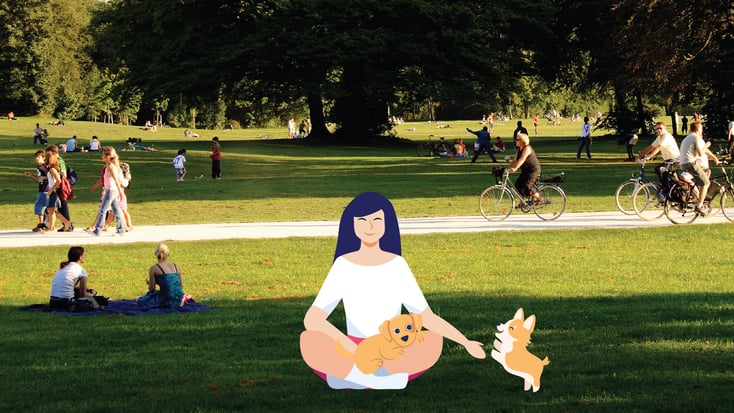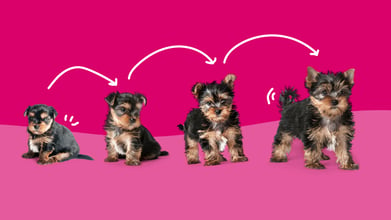How to Socialize a Puppy: 7 Easy-to-Follow Steps

Table of Contents
Puppy socialization is more than introducing your puppy to other puppies or dogs. Socializing a puppy involves introducing them to the world around them, including new people, places, and other pets. As a responsible pet parent, you must teach them how to react and behave appropriately when exposed to new situations.
This blog will teach you how to socialize your puppy correctly!
Key Takeaways:
- Puppy socialization involves exposing your puppy to new people, animals, environments, and experiences in a positive and controlled manner.
- Start socializing your puppy as early as possible, ideally before 16 weeks, after receiving their first round of vaccines and one round of deworming.
- Socializing a puppy helps them develop social skills, build confidence, and become comfortable in different situations, reducing the risk of fear or aggression.
What is Puppy Socialization?
Puppy socialization refers to exposing a young puppy to various people, animals, environments, and experiences in a positive and controlled manner. It aims to help the puppy develop social skills, build confidence, and become comfortable and well-adjusted in different situations.
Related reading: New Puppy Checklist: Starter Kit of Essentials
When to Socialize a Puppy?
It is recommended to start socializing a puppy as early as possible, ideally before 16 weeks of age. However, it is essential to wait until the puppy has received their first round of vaccines and one round of deworming to minimize the risk of exposure to infectious diseases. After that, continue socialization efforts throughout their development for optimal results.
Why Should You Socialize a Puppy?
Socializing a puppy is crucial as it teaches them how to interact with the world positively and confidently, reducing the risk of fear or aggression. Proper socialization exposes puppies to different people, animals, environments, and experiences, helping them develop essential social skills, adaptability, and resilience. It promotes a well-rounded and well-behaved dog throughout their life.
How to Socialize a Puppy
Our veterinarians recommend the following seven steps to begin socializing your puppy. Feel free to use these steps as a puppy socialization checklist!
1. Introduce Them to New People
Once your puppy has received their first round of immunizations and you have received the go-ahead from your veterinarian, introducing them to new people is generally considered safe. Meeting new men, women, and children will help your puppy connect with different people positively.
When your puppy meets new people, you can start working on discouraging behaviors like jumping, barking, and biting. Encourage your friends and family to offer your puppy treats and show them affection so that your puppy will associate new people with positive experiences.
2. Introduce Them to Other Puppies and Dogs
It is generally safe to introduce your puppy to other puppies and dogs at around 16 weeks of age or after they have completed all of their vaccine series is completed. Puppy playdates are a great way to introduce your puppy to other puppies their age with a similar energy level or dogs that are friendly and well-behaved.
3. Introduce Them to New Places
If your puppy is fully vaccinated, it is a good idea to start exposing them to new places to learn to be comfortable outside of the home. Puppy classes, a dog-friendly outdoor restaurant, a pet store where our furry friends are allowed, or a public walking trail may all be good places to try with your pup.
Let your puppy explore these new environments at their own pace, and reward them with treats and verbal praise. If your puppy becomes scared or overwhelmed, that's your cue that it's time to return home.
4. Teach Them Basic Commands
Teaching basic commands, such as sit, stay, and come, will help you maintain control of your puppy's behavior in new situations. Positive reinforcement is a critical component of socializing a puppy. Use treats, praise, and physical affection to reward good behavior. This way, your puppy will associate positive experiences with new people, animals, and environments.
Find out what rewards are likely to motivate your puppy the most during the training process by taking our fun Pet Love Language Quiz.
5. Go at Your Puppy’s Pace
While allowing your puppy to meet new people and explore new places is essential, follow your puppy's lead. If your puppy exhibits signs of fear or discomfort or becomes overstimulated, take a step back and try again another time.
6. Watch for Signs of Stress
Monitor your puppy's body language for signs of stress, such as panting, pacing, yelping, or hiding behind you. If you notice these signs, take a break from the socialization session and try again later. Never force your puppy to remain in a situation where they appear overly stressed or fearful.
7. Be Consistent
Consistency is vital when socializing a puppy. Gradually increase the duration and intensity of each socialization opportunity. Socializing your puppy is essential in the development process and can facilitate growth into a well-adjusted and confident adult dog. Remember to start early, be consistent, and watch for signs of stress. With proper socialization, you'll set your puppy up for a happy and healthy life.
Conclusion
Socializing your puppy is crucial for their development and overall well-being. By introducing them to new people, other puppies and dogs, and new places, you are helping them build positive associations and learn appropriate behaviors. Go at your puppy's pace, watch for signs of stress, and be consistent in your socialization efforts.
If you're finding it challenging to socialize your puppy or are concerned about their behavior, consider scheduling a behavioral consultation with a professional veterinarian. They can provide expert guidance tailored to your puppy's needs and help you address behavioral issues.
Book a puppy check-up today to ensure they receive support for a well-rounded and socially confident life.
Stress-Free Wellness Exams for Your Growing Fur Baby
With our in-home visits, your kitten or puppy can snooze away while we keep their vaccines up-to-date and ensure they're on the right paw to a healthy and happy life.
Frequently Asked Questions
How late is too late to socialize with my puppy?
You should begin socializing your puppy before 16 weeks, which is considered the best puppy socialization period. After 16 weeks, your puppy may be less open to new experiences with people and pets.
Can I socialize my puppy too much?
Your growing puppy needs much downtime, so you don't want to overdo it. Pay attention to your puppy’s cues and take a break when your puppy seems tired, overstimulated, or overwhelmed.







